9 Call Center Tracking System Software Options


Call center tracking systems help teams keep tabs on every customer or prospect call in order to track, record, and analyze interactions. This allows them to improve performance, stay compliant, and ensure a positive experience for each customer.
These tools are used across different types of call centers, including:
- Sales and marketing call centers, where teams track which campaigns drive calls, assess lead quality, and tie revenue back to specific marketing efforts.
- Customer support or success call centers, where agents use the insights to improve service quality, identify recurring issues, and improve the overall customer experience.
In this article, we’ll break down how different teams use call tracking software and what features matter most. We’ll also highlight 9 top tools, including our own call center tracking software, Level AI, which includes secure and customizable Generative AI capabilities.
If you’re looking to connect calls to campaigns, improve team performance, or get more customers, this guide is for you.
Keep reading or jump straight to the relevant product below:
Tracking Tools for Customer Service
Tracking Options for Sales & Marketing
Tools for Customer Support: Track, Analyze & Improve
Call center tracking tools help teams review conversations, spot patterns, and boost service quality. Some offer real-time alerts when an agent needs help; others use AI to suggest coaching tips automatically. Features vary, so it’s important to choose a tool that fits your team’s needs, especially if you handle both inbound and outbound calls.
Here are five top options:
1. Level AI: One Platform to Track, Analyze, and Coach
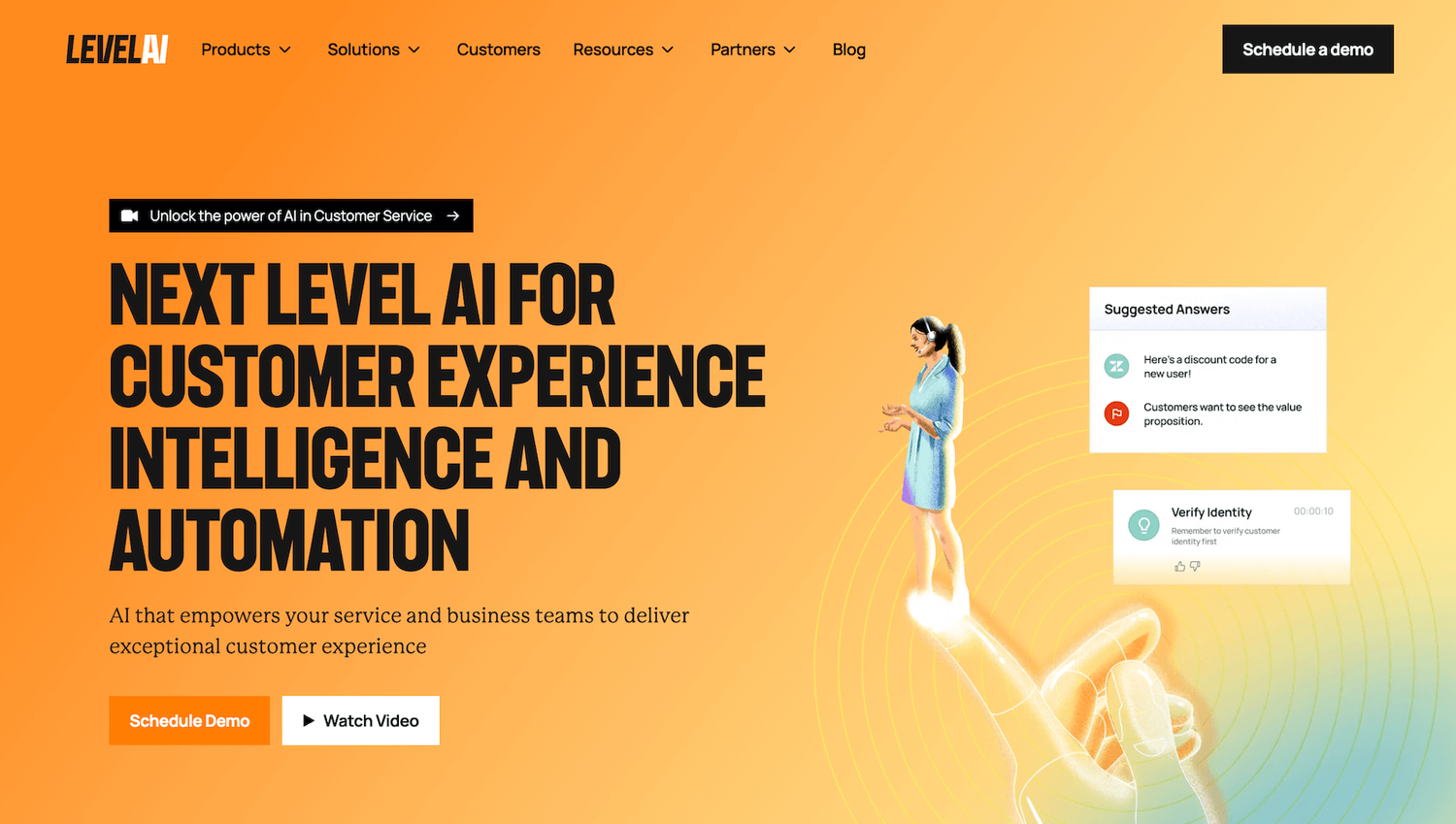
Level AI tracks every call, and shows you exactly what’s going wrong, what’s working, and where to improve.
Many tracking tools log call data. Level AI goes further by analyzing every conversation with AI that actually understands what’s being said. The program flags issues in real time, allows you to coach agents in real time, and surfaces the trends that matter most. So, you’re not just tracking calls: you’re turning them into actions that boost performance and customer satisfaction.
Capture the Why Behind Every Call
On average, quality assurance teams review 1–2% of calls, which can reveal certain trends, but not all of them. This approach serves well to capture outlier calls (especially very bad or very good ones), but makes it easy to miss the recurring problems that fly under the radar.
If only a tiny sample of conversations is being analyzed, it may skew perception and lead teams to miss the everyday patterns that drive the majority of call volume. It may take weeks or months to notice a recurring product defect, policy confusion, or service issue.
Another challenge is that human reviewers may not evaluate calls consistently: different people may classify similar conversations in their unique ways depending on the call, their mood, or their attention to certain details.
This is why most call center tracking solutions analyze all customer calls, so that teams get a full and unbiased view of contact center conversations. However, not all of them are using the same approach to call transcript analysis: some rely on matching specific terms in transcripts to surface calls with specific topics, while others rely on generative AI that comprehends natural language.
We recommend avoiding solutions that rely on keyword matching or rules-based algorithms to surface insights, since they can miss context, misunderstand intent, and require manual updates to stay accurate.
In order to be completely accurate, the QA team must list all possible keywords signalling a certain intent, such as “give back,” “return,” or “send back”. These lists must be exhaustive, so it is practically impossible to cover all ways a customer might phrase a product return request.
Level AI’s Scenario Engine, in contrast, uses AI speech analytics to analyze, detect, and classify intents expressed by customers and agents, registering these as scenarios. This removes the need for you to think of and input every possible keyword that could be used to signal an issue (like every possible way a customer may ask for a return).
Instead, the tool will understand issues by parsing natural language and noting patterns for you. For example, if a customer asks about billing, plan options, and switching plans in one call, the Scenario Engine identifies each as a distinct scenario.
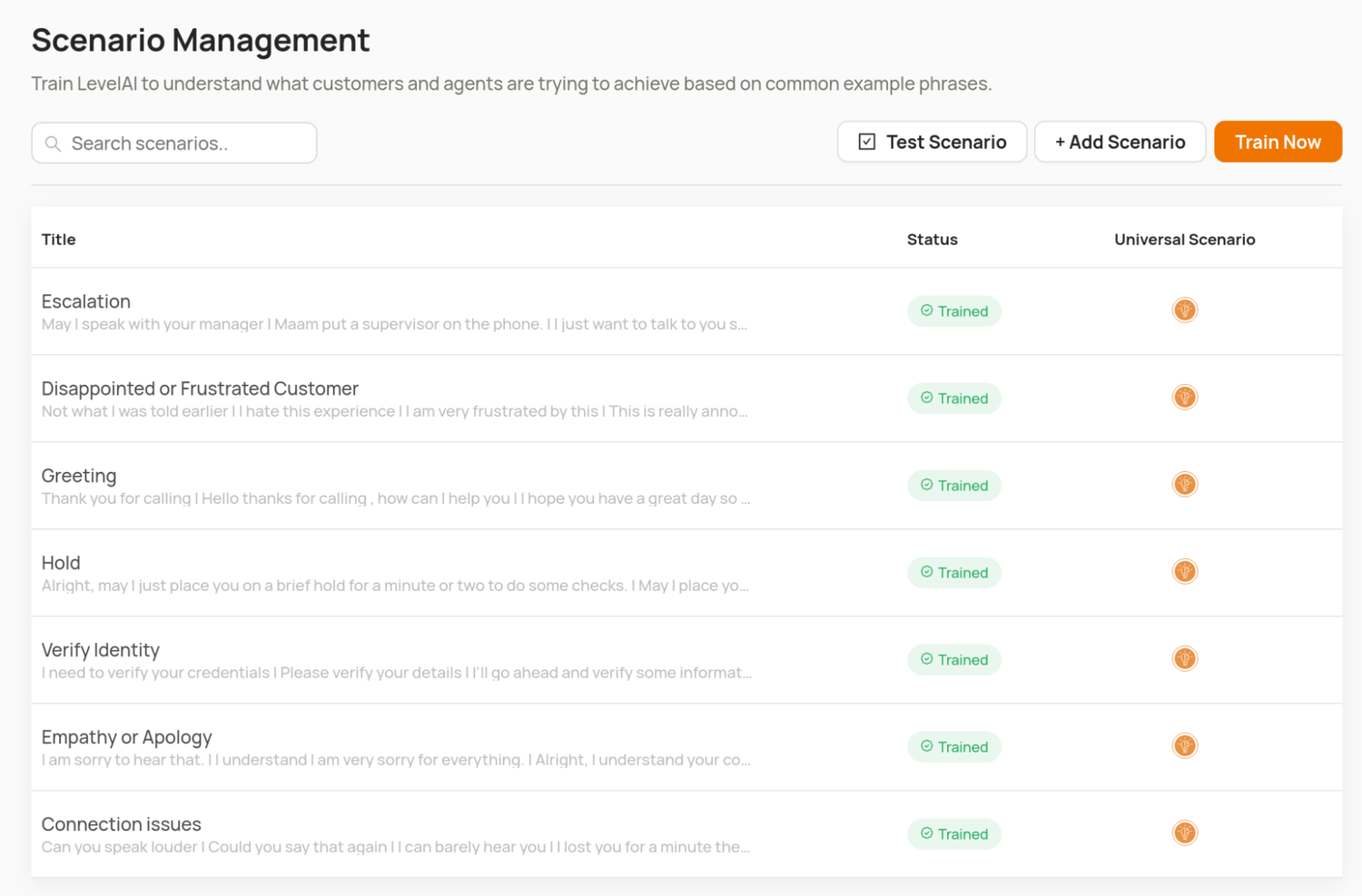
Standard customer support scenarios are already available out-of-the-box. Companies can also add their own business-specific scenarios and train the AI to recognize them by entering a few representative phrases a customer might say.
Once a scenario is identified, it’s also associated with a conversation tag, such as “Billing” or “Pricing question” to make it easier for teams to surface curated lists of conversations containing a particular scenario.
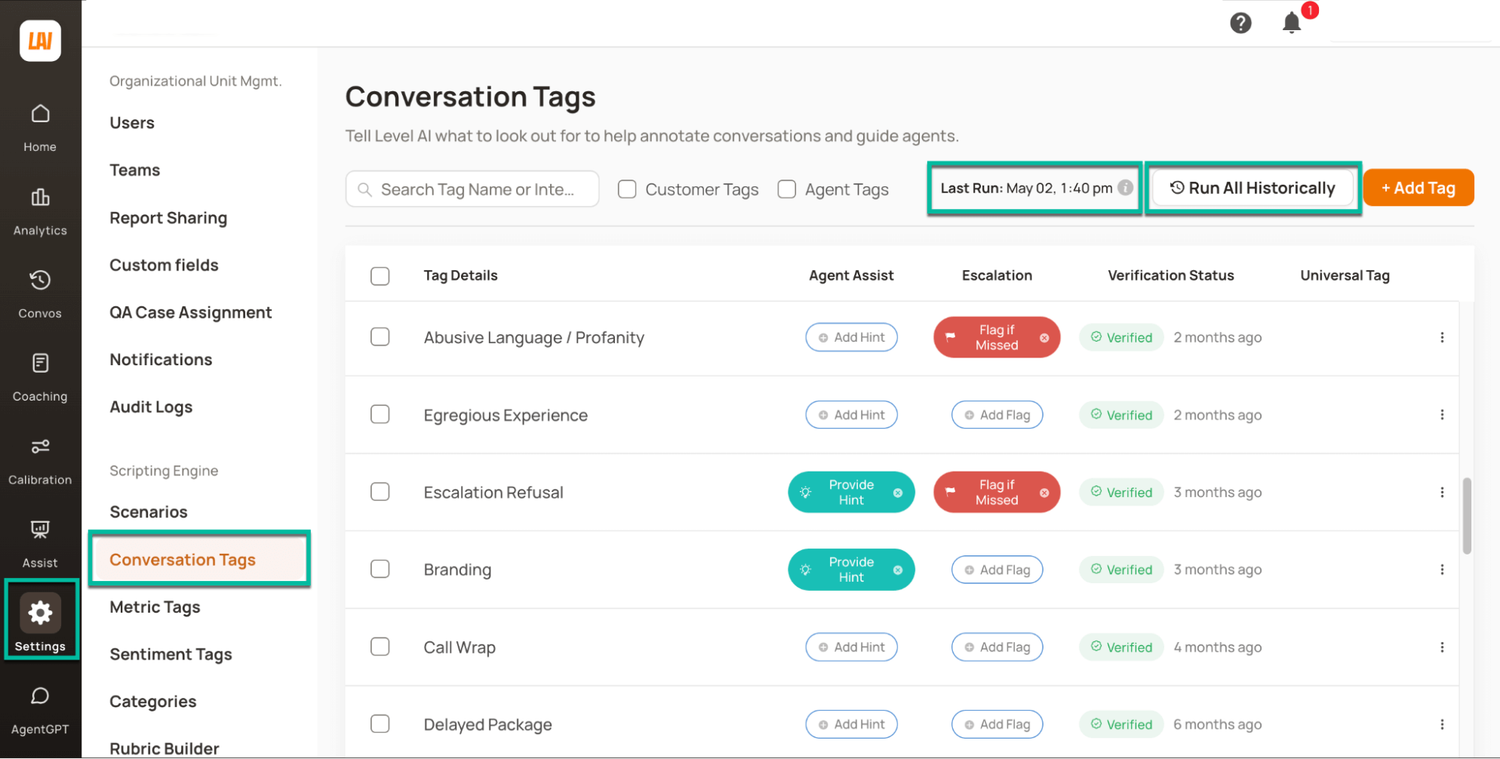
Beyond Positive and Negative Sentiment: Real Emotion, Real Insights
Many call center tracking systems have some kind of customer sentiment analysis method that measures only the direction and intensity of customer feelings, labeling these as positive, negative, or neutral sentiments.
While helpful at a glance, this broad categorization misses the deeper emotional layers hidden in customer interactions. Important feelings, like disappointment, worry, or annoyance, often get lumped into the same "negative" bucket, even though they demand very different responses.
Without recognizing these different emotions, call tracking systems can't uncover the real reasons behind customer satisfaction or frustration, leaving teams without the insights they need to truly improve service.
For these reasons, Level AI goes beyond “positive” and “negative” labels and captures the highest range of emotions on the market including:
- Happiness
- Admiration
- Gratitude
- Worry
- Disapproval
- Annoyance
- Disappointment
- Anger
Our platform also takes into account varying emotions occurring over a single interaction and assigns an overall Sentiment Score to the conversation, ranging from very positive (10) to very negative (0).
This allows you to quickly gauge the emotional tone of an entire call without combing through the transcript. It also highlights shifts in sentiment over time, making it easier to spot conversations that start tense but end on a positive note, or vice versa.
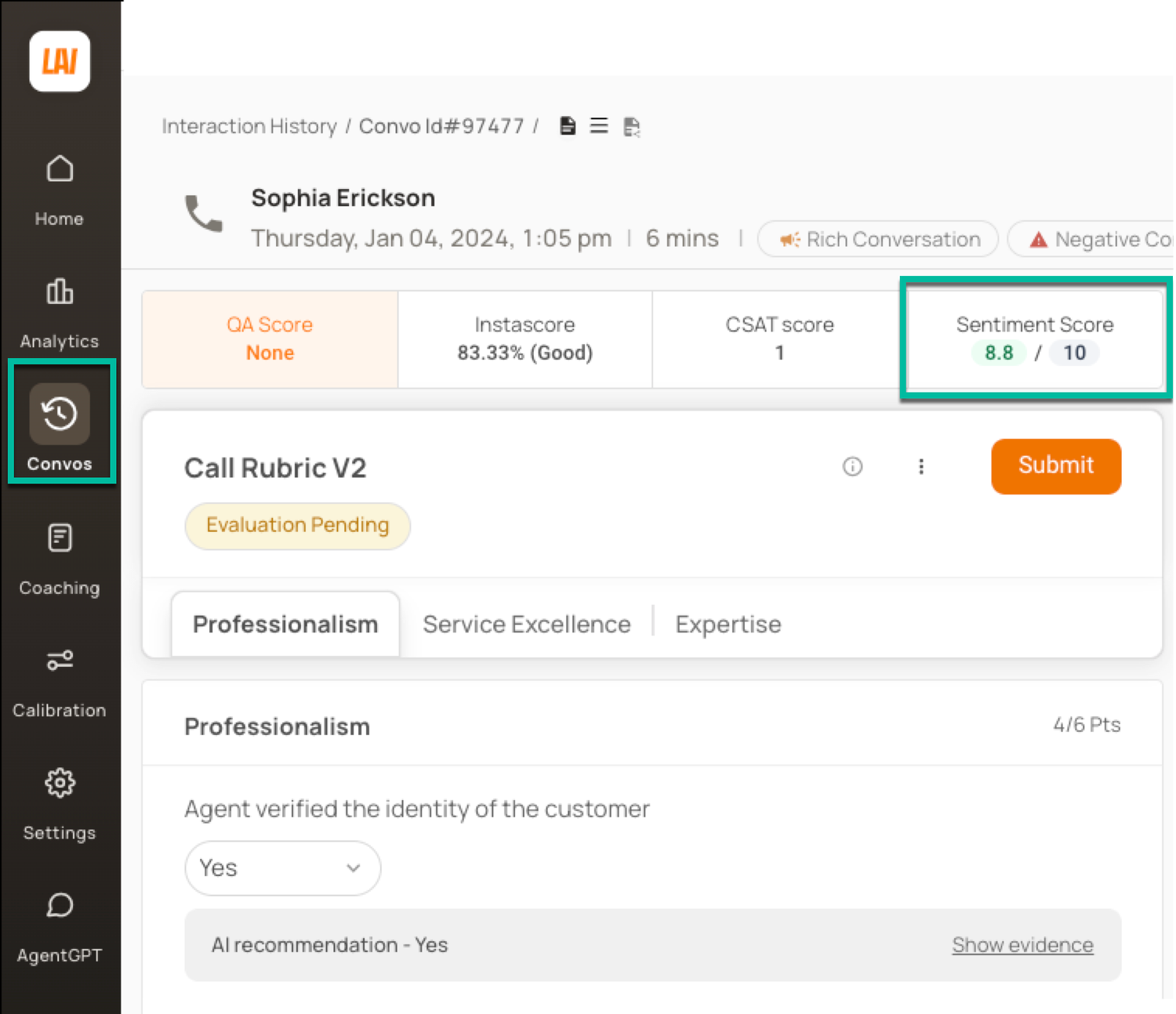
The Sentiment Score is a weighted calculation across all emotions expressed by a client during an interaction. More weight is assigned to emotions expressed towards the end of the call, since these have more impact on how customers will feel about your brand, product, or service after it’s over.

Level AI identifies clear instances of emotions being expressed in conversations using sentiment tags. These show occurrences of each of the eight emotions listed above, allowing you to create curated lists of interactions where a particular emotion was detected.

You can also use them to build reports that combine other data and metrics (from both outside and within our platform) to answer questions like:
- Which customer queries are associated with the highest level of negative emotions expressed?
- Which agents are generally more successful at resolving such queries and issues, and how do they do that?
- Do certain agents consistently receive lower sentiment scores, suggesting they may need additional coaching?
Quickly Identifying Personalized Agent Coaching Opportunities
To quickly improve agents’ performance, QA teams and managers need to efficiently identify performance gaps and prioritize training opportunities for each agent. Without AI assistance in place, they would need to review multiple calls from an agent to separate incidental mistakes from consistent errors. This can be time-consuming and does not allow for effective, personalized coaching for a large team.
Call tracking solutions help identify instances when agents aren’t complying with company guidelines or using best practices during the conversation. These might typically include measurable behaviors such as excessive hold times, frequent call transfers, or failure to follow the prescribed call flow.
Our platform goes further by automatically rating agent performance in real time or through post-call analysis and flagging instances when agents aren't following scripts, using required compliance language, or demonstrating key soft skills like empathy or active listening.
Level AI’s InstaScore quantifies agents’ performance by measuring how well agents comply with company-specific rubrics. For example, measuring how well a specific agent follows scripts or handles conflict.
This is expressed as a single percentage value for any given interaction, like 64% or 89%, immediately showing you whether agents are falling short or doing well.
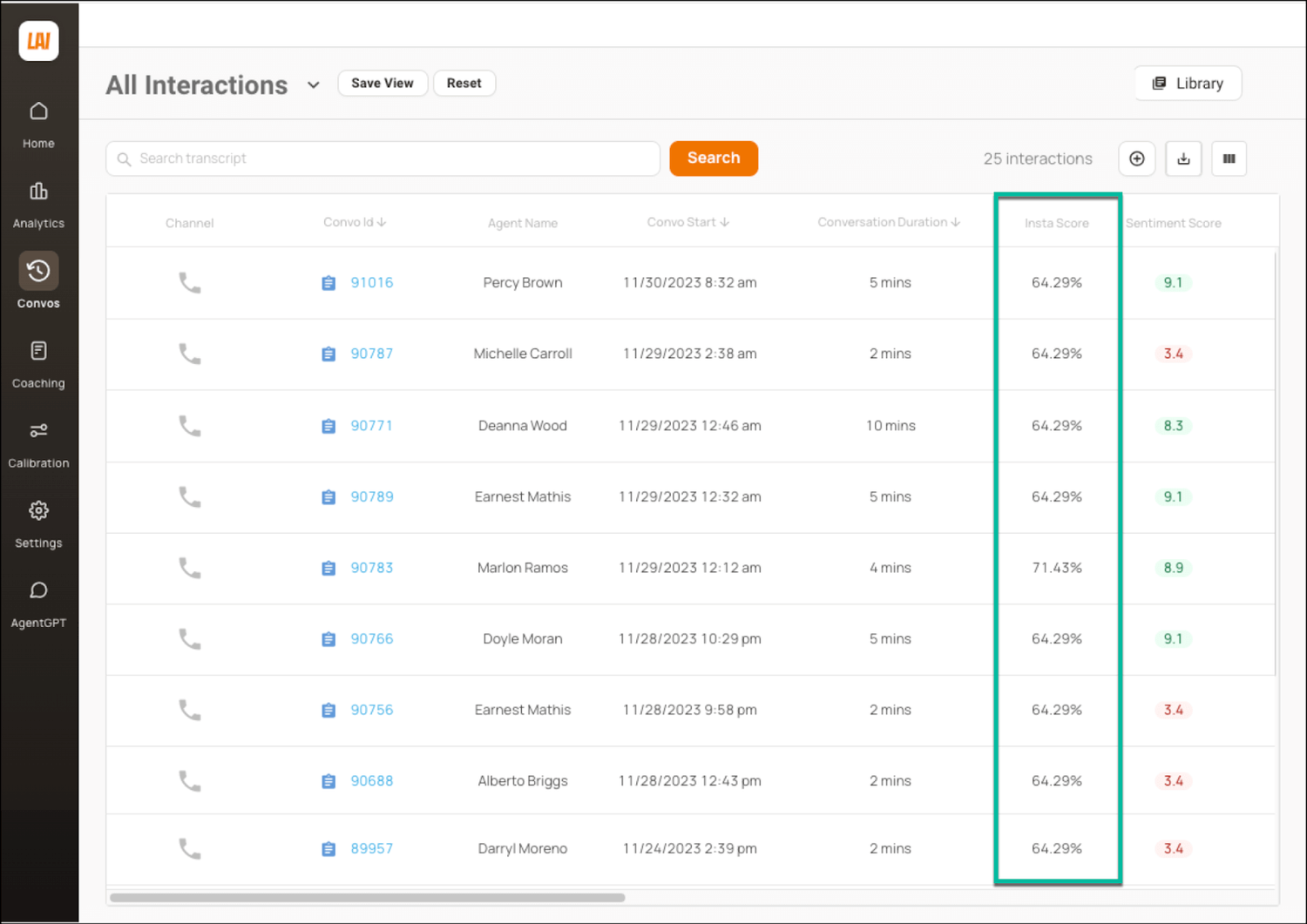
InstaScore can help you quickly decide which calls to look further into, speeding up agent performance reviews.
Two other Level AI features can additionally help you determine opportunities for agent coaching:
- Screen recording analysis
- InstaReview
Analyzing screen recordings helps uncover:
- General issues that slow resolution, such as inefficient workflows or missing resources.
- Specific issues that agents struggle with: not understanding how to use the software, not being aware of shortcuts, or not being able to quickly find necessary information.
- Compliance issues, where agents don’t follow company best practices.
InstaReview automatically generates a list of conversational moments, both positive and negative, which can indicate to QA teams and managers potential opportunities for coaching agents. This includes negative interactions resulting in low customer satisfaction, high numbers of agent requests for assistance, or calls with unusually long durations.
You can share any call center analytics dashboard or performance stats with agents to give them added context for their own performance:

Helping Agents in Real Time, Before Issues Escalate
Agents sometimes recognize when a call is going south and ask for help, but other times they’re too overwhelmed to realize it. That’s why managers need a way to step in at the right moment, not after it’s too late.
Listening to every live call isn’t realistic, so most call center systems rely on basic alerts. Unfortunately, many systems only flag long calls, missing frustrated customers or flagging harmless ones that just take time to resolve.
Level AI’s Real-Time Manager Assist fixes that by giving managers more targeted and accurate signals when an agent actually needs help.
Our call center agent monitoring software displays all ongoing calls on a live dashboard and instantly flags instances when an intervention may be necessary. The dashboard displays insights like:
- Sentiment Score, indicating how satisfied or dissatisfied customers are during the conversation in progress
- InstaScore, showing how agents well agents are doing
- Call duration
- Coachable insights flagging instances such as “rude behavior,” or “bad negotiation”
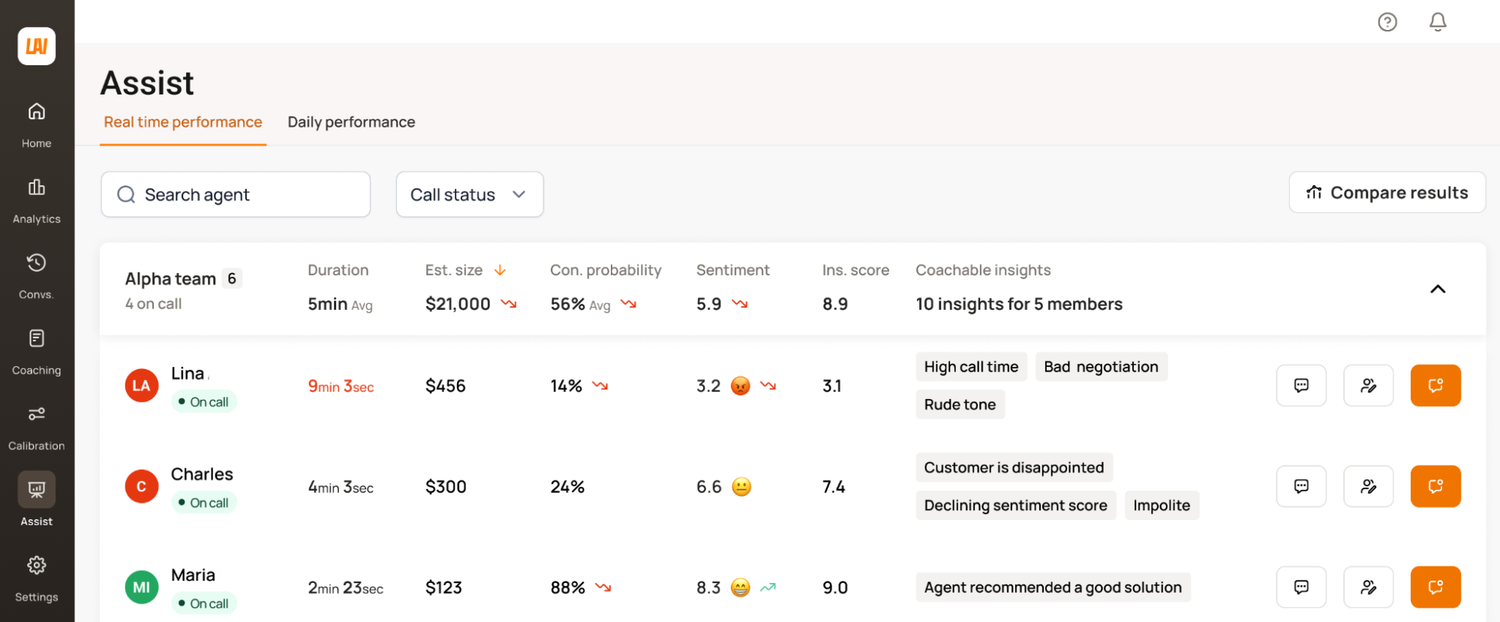
Managers can click on any of the metrics or insights to view transcript details highlighting what exactly is being said (and where) in the call. They can also jump on the call to resolve the issue, or use call whispering to coach agents in real time.
(Read our latest article on How to Monitor Call Center Performance.)
Uncovering Subtle or Hidden Trends and Patterns to Improve Customer Satisfaction
Finding real, consistent patterns across customer conversations isn’t easy.
Support teams sometimes miss issues that affect satisfaction, like missing product info, confusing call flows, or broken self-service options, because they’re buried (in various ways) in everyday calls.
You could manually dig through call transcripts or run keyword searches, but that’s slow and tedious. You’re likely to miss hidden problems you don’t even know to look for.
Surveys aren’t much better. They mainly capture extreme opinions, like customers who are either thrilled or upset, while sometimes missing the average experience that drives most satisfaction scores. Plus, surveys take time to analyze, meaning it can take weeks to spot serious issues.
(Read our latest article on top SurveyMonkey alternatives.)
Level AI’s Voice of the Customer (VoC) Insights automatically spots patterns from natural conversations and measures customer satisfaction, allowing teams to find subtle issues faster and make smarter decisions without the guesswork.
Such data is displayed in intuitive, customizable dashboards that make it easy to spot patterns at a glance. You can filter by topic, sentiment, or timeframe, and share key trends with stakeholders in just a few clicks:
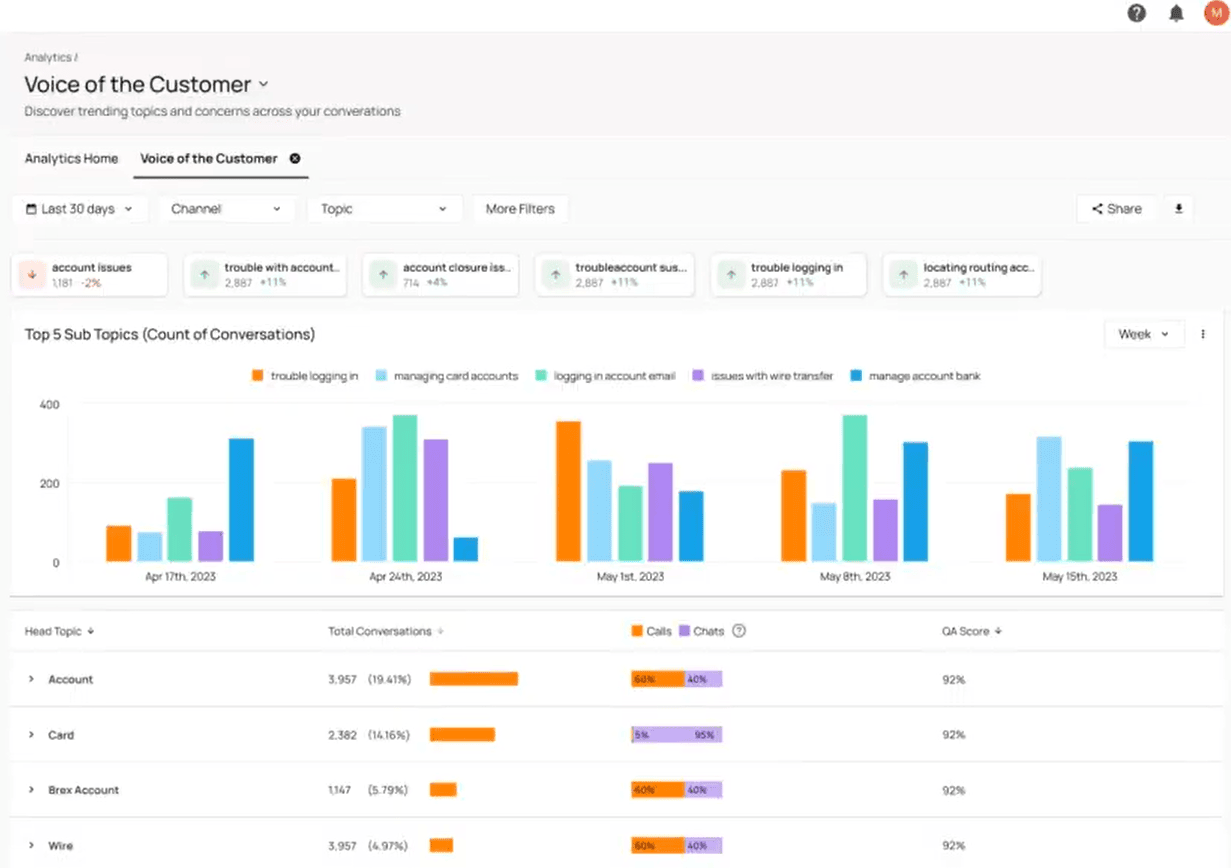
VoC Insights also tracks standard satisfaction metrics that teams normally obtain through post-call surveys, such as CSAT, NPS, CES and more.
These key performance indicators are pulled directly from natural conversations (no surveys needed) using call center voice analytics, saving you time and helping you avoid decisions based on incomplete or biased feedback.
Having access to automatically generated KPIs across all calls, especially our iCSAT (inferred customer satisfaction) score, makes it easier to find connections between customer intent, agent behavior, and call outcomes.
iCSAT takes into account resolution status, sentiment score, and customer effort score (for example, long wait times, multiple transfers and so on) to deliver a more complete and accurate picture of how customers truly feel about their experience
The score is measured on a scale of 1 to 5, where 1 means very dissatisfied and 5 is very satisfied.
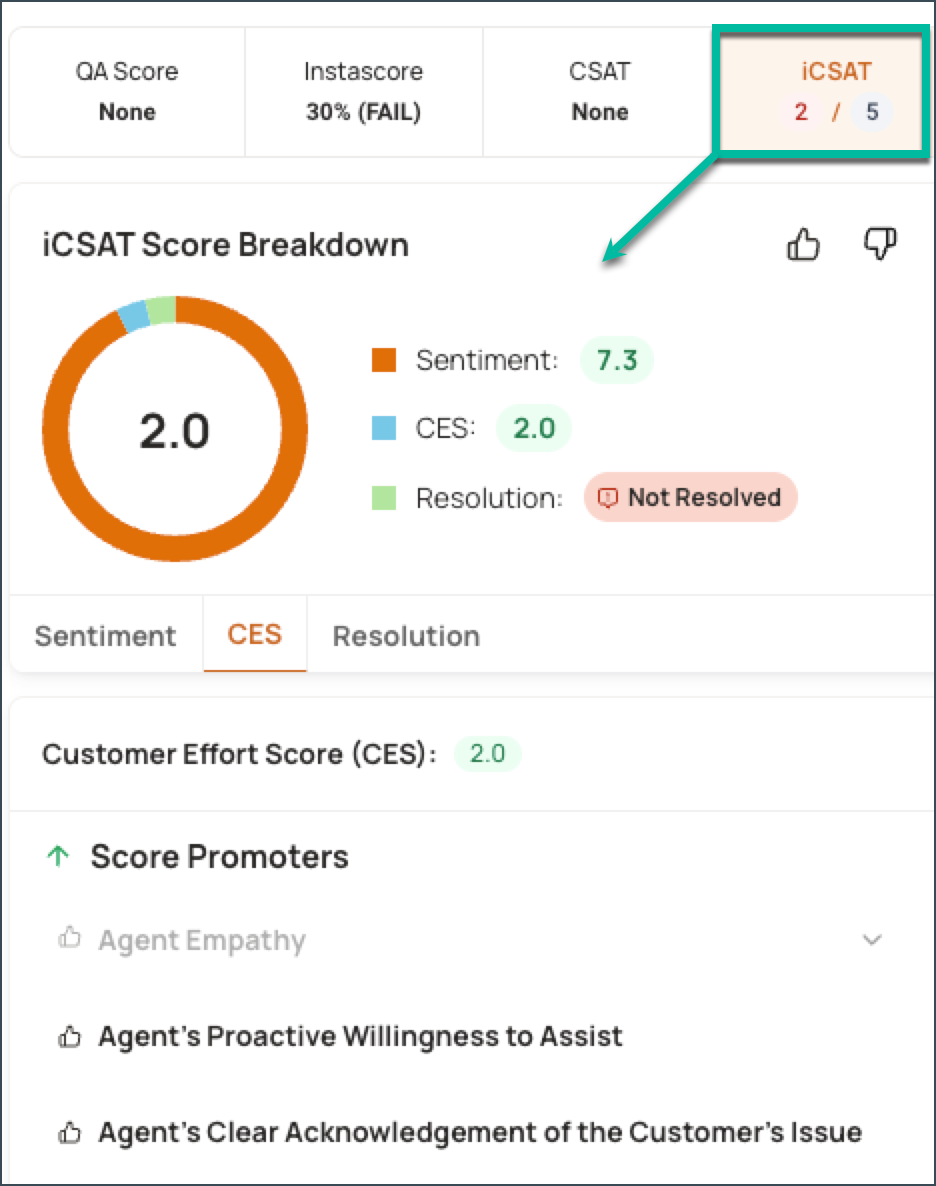
When building reports from disparate data sources across your contact center, scattered data makes it hard to see the full story behind your customer experience.
Level AI solves this by unifying call data, VoC insights, CRM records, ticketing systems, and more, giving you one place to track trends, performance, and outcomes.
You can dive into ready-made dashboards or build your own custom reports with our Query Builder, sorting by KPIs, timeframes, agents, and other filters that matter to your team.
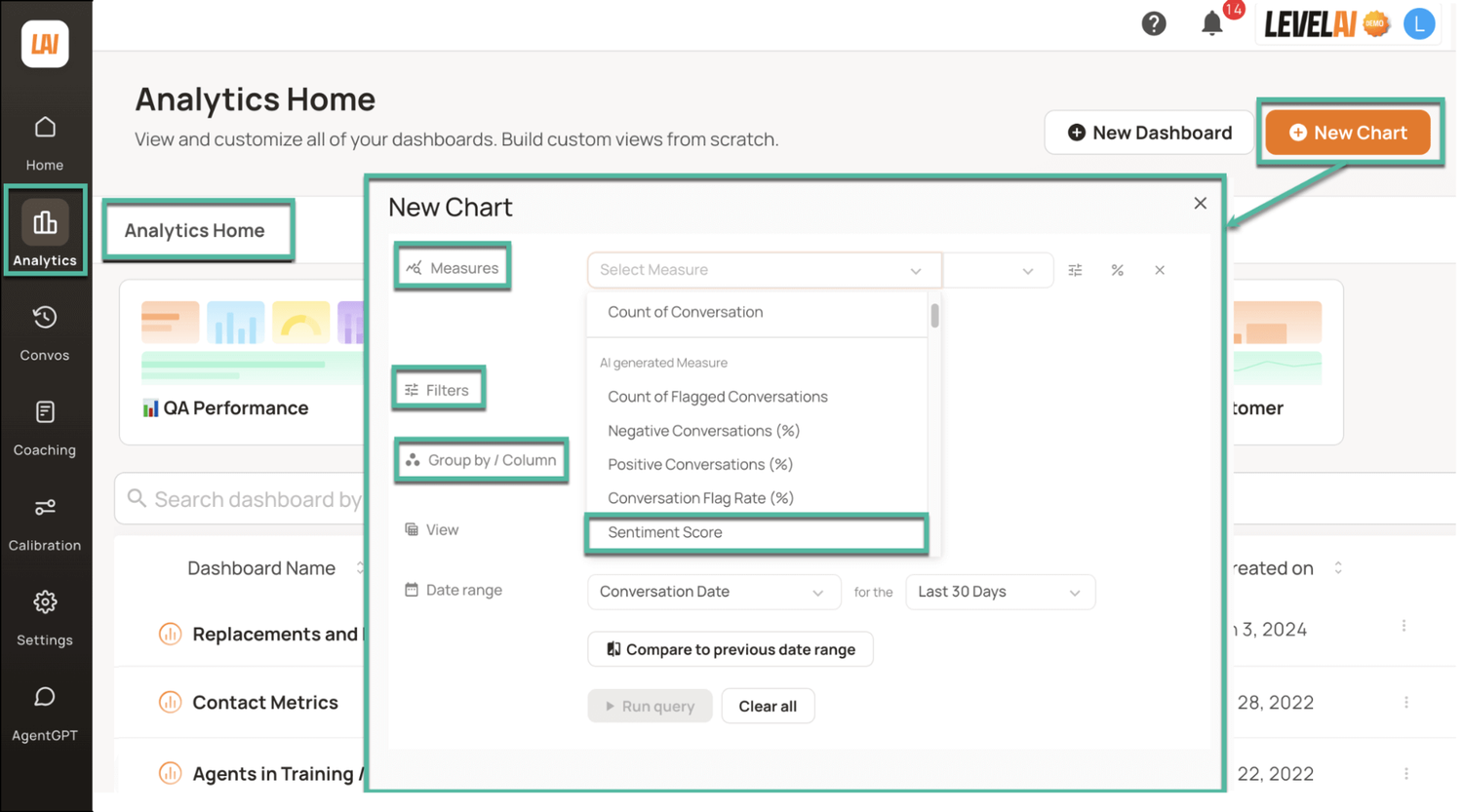
Reporting dashboards can be integrated via API with your external systems to pull in additional customer data and provide a complete picture of customer interactions.
Unlock the Full Power of Your Call Center
Level AI is a customer experience platform that monitors 100% of calls and helps call center managers and QA teams evaluate agent performance in real time, while identifying the causes behind low CSAT scores.
One of our customers was able to improve the first-call resolution rate by 76% after identifying primary call scenarios and training agents how to resolve them. Another customer used coaching insights from analyzing customer feedback to reduce average handle time by 20% and increase first-call resolution rates by 15%.
To see how Level AI helps you track calls and find new ways to improve customer satisfaction and call center efficiency, schedule a free demo today.
2. Zendesk: Unified Contact Center and Help Desk Management

Zendesk is an omnichannel contact center software solution that combines call center tracking with help desk support and workforce management. It supports website chat, SMS and social media messaging, as well as calls. In addition to standard call center tracking features like quality management, Zendesk helps reduce human agents’ workload by enabling AI agents for voice and text interactions.
Zendesk plans start at $19 per month per user. However, AI agents are only available on higher-priced plans, starting at $55 per user per month.
3. Talkdesk: Integrated Contact Center with Intelligent Routing and QA Tools
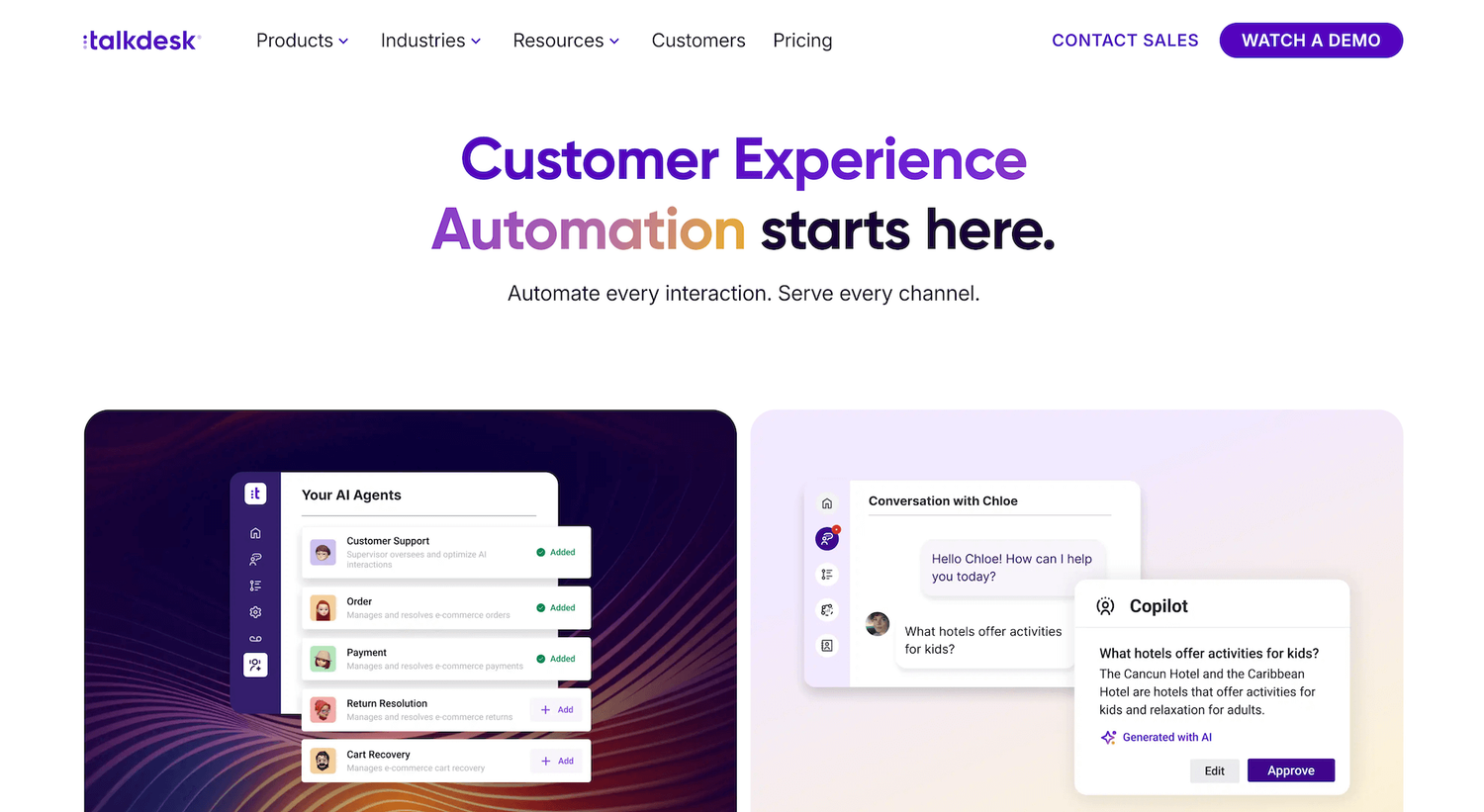
Talkdesk is a contact center software focused on resolving customer issues faster through in-call agent support, smart routing, and AI agents taking over the handling of simpler customer queries. This solution can also be used by sales teams for outbound calls.
In addition to reducing agents’ manual workload, Talkdesk also helps quality assurance teams and managers analyze agents’ and call center performance and streamline workforce management tasks.
It has different pricing plans:
- Industry-focused packages for banking, insurance, retail, healthcare providers etc. starting at $225.
- CX Cloud packages, starting at $85 per user per month.
4. RingCentral: Integrated Voice, Messaging, and Contact Center Analytics
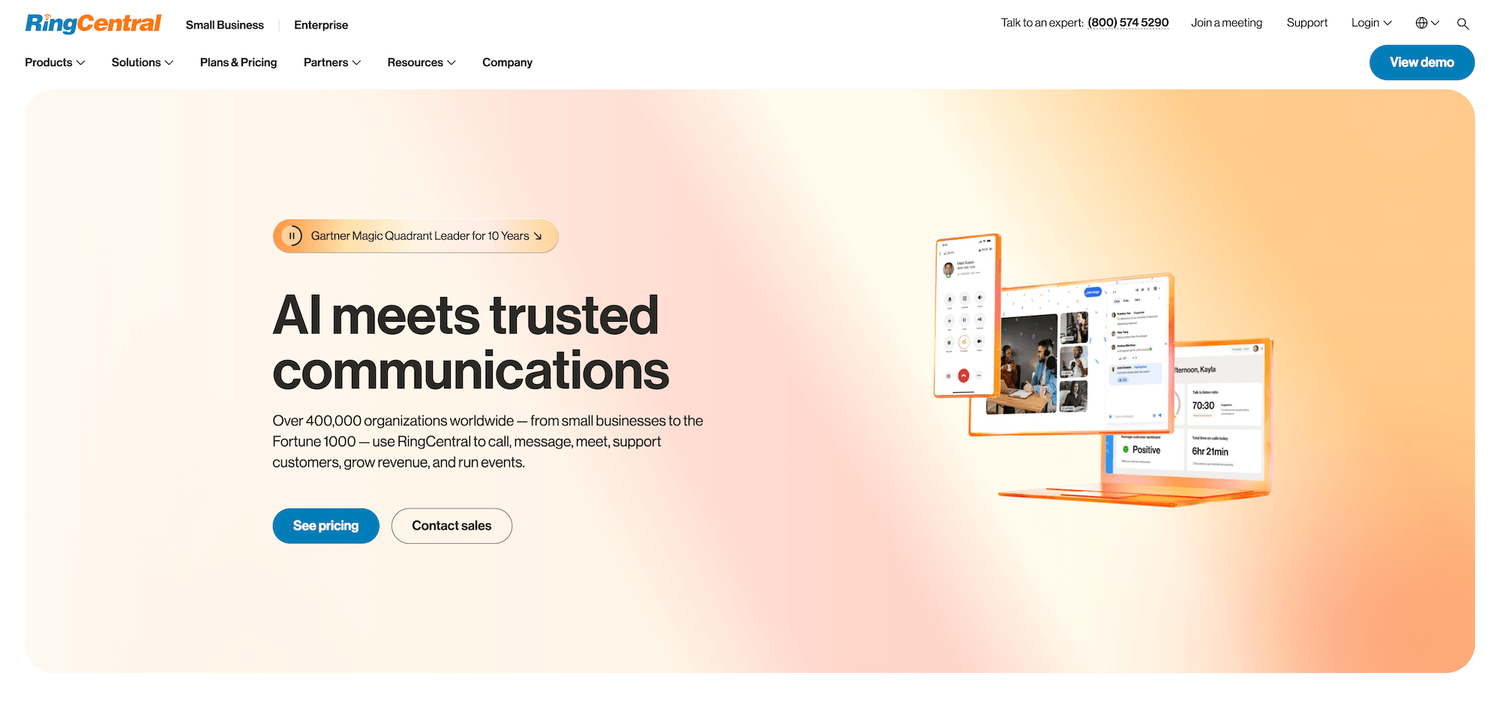
RingCentral is a digital communications platform that supports event management, business communications, and inbound and outbound contact center management. Customer support teams can use RingCentral to monitor conversations, score call quality, and support call center agents and supervisors through AI-powered tools, including analytics.
RingCentral offers a standard RingCX plan that starts at $65 per agent per month when paid annually, as well as an enterprise plan (no pricing information available at the time of writing).
5. Dialpad: Integrated Call Center and Productivity Platform

Dialpad’s call center software combines AI-powered communications, outbound sales, and customer support capabilities. It provides automated call analysis for better quality management, and helps agents be more productive by deflecting calls, providing self-service options, and supporting agents during conversations.
There’s no free tier available, but Dialpad offers a free trial. Pricing starts at $15 per user per month when paid annually. However, CRM integrations are only supported at higher tiers, starting at $25 per user per month with annual billing.
Tools for Sales & Marketing: Connect Calls to Campaigns
These call center solutions help companies understand which marketing channels bring in the most customers, and analyze those conversations to optimize their marketing efforts. Most software tools for this use case can provide attribution for incoming phone calls, identify high-performing ads, and optimize customer touchpoints.
Below, we introduce top 5 call center tracking solutions for marketing attribution.
1. Invoca: Marketing Attribution and Call Conversion Analytics
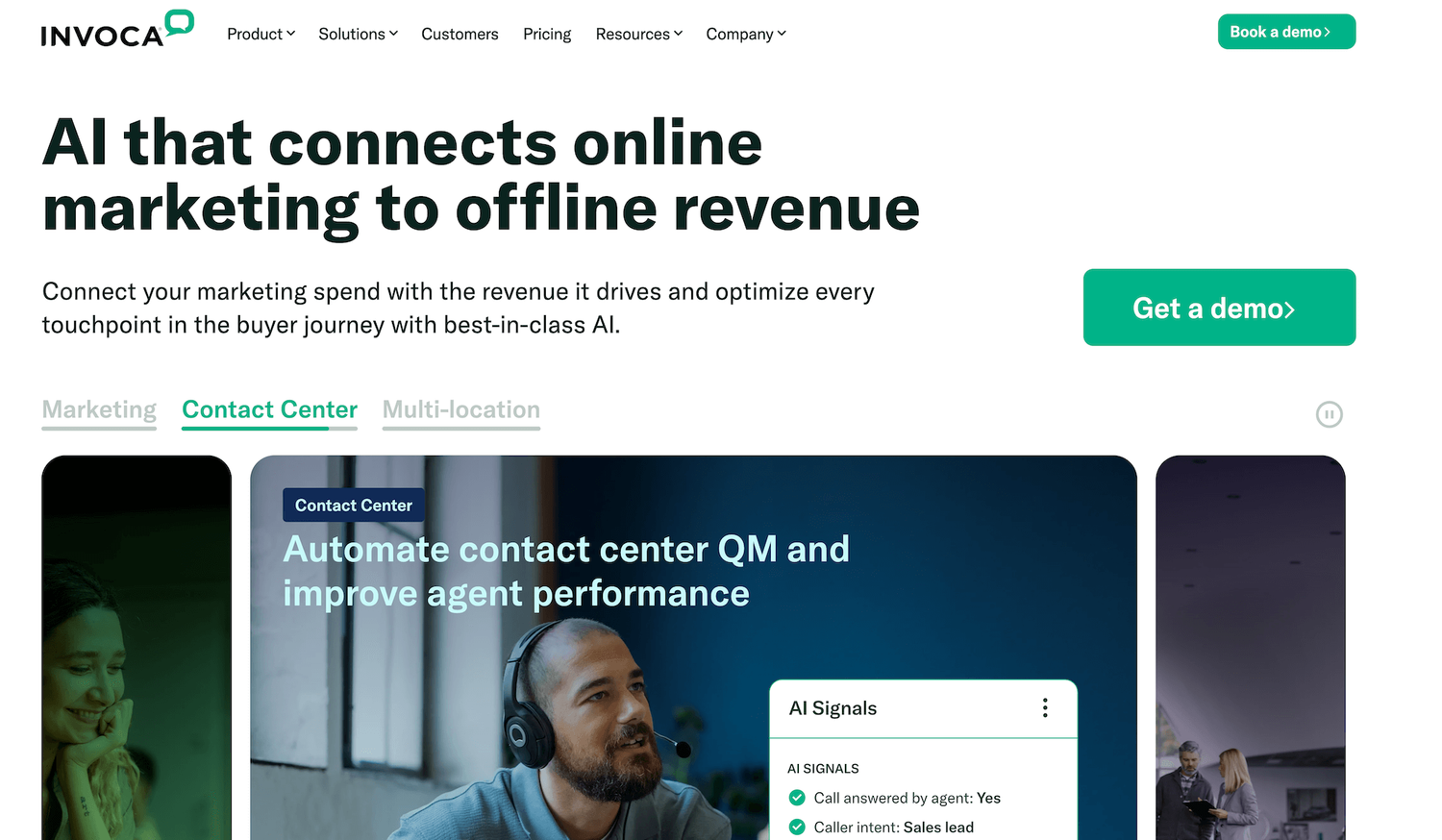
Invoca supports all the call tracking features you expect from this type of software. It also analyzes performance metrics, showing which ads, campaigns or messaging contribute to positive phone call outcomes.
Additionally, Invoca tracks every caller’s digital journey and shows that information to sales agents, helping them personalize their conversations. To improve call conversion rates, it also offers automated coaching and performance tracking.
Invoca doesn’t have pricing available on their website. However, their pricing page shows available features and usage limitations for several pricing plans:
- Plans for brands and agencies, further broken down into call centers and multi-location companies.
- Plans for pay-per-call and affiliate marketing businesses.
2. CallRail: Inbound Call Tracking and Marketing Attribution
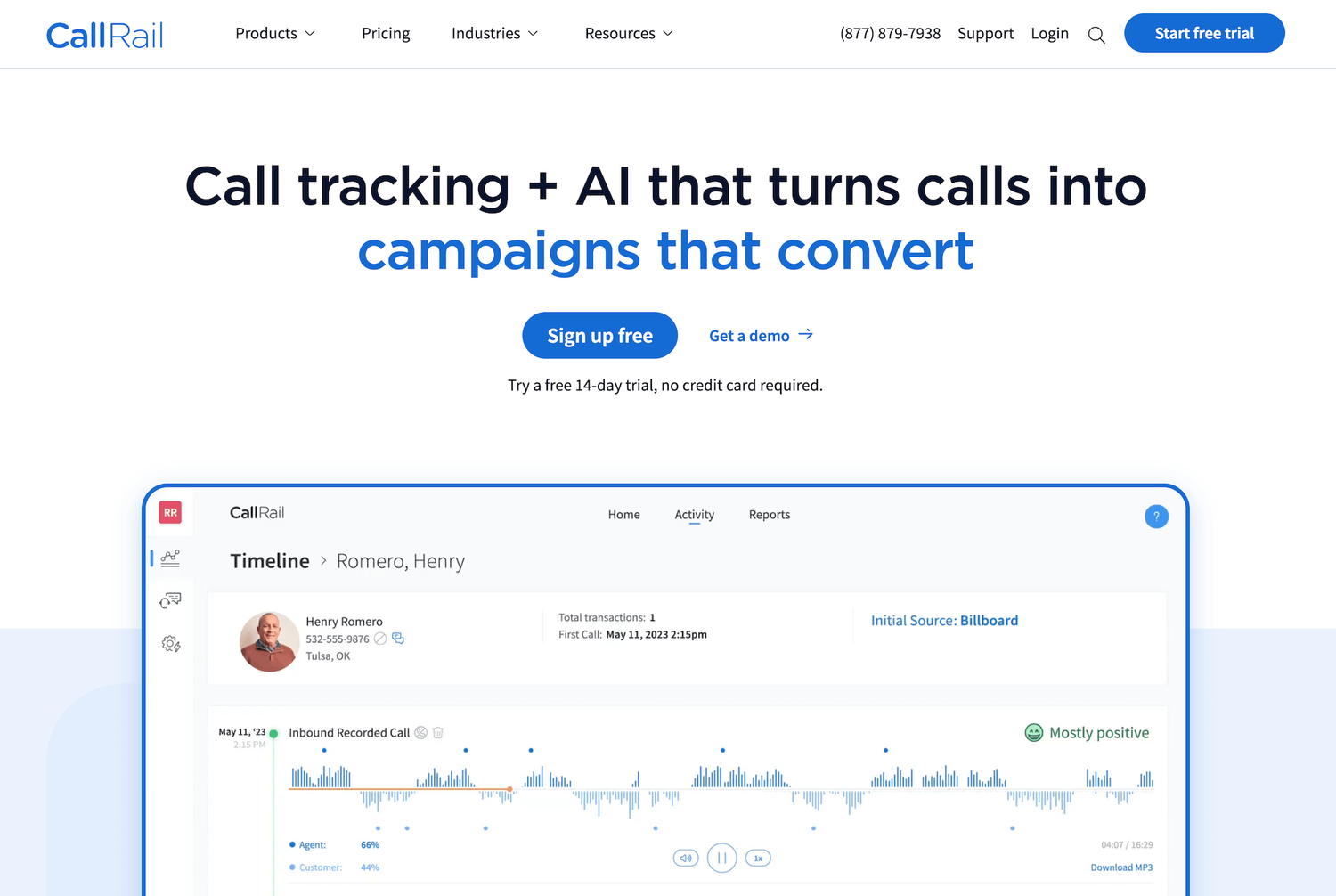
CallRail is a call tracking and marketing analytics software for inbound calls that helps teams identify winning channels, for example, social media ads, campaigns, and web forms. It integrates with 50+ tools, from Google Ads to HubSpot and Salesforce for easy setup and tracking. CallRail can be set up to route leads to the best-fit salesperson, and qualifies leads in real time so that sales agents can focus on high-intent prospects.
Pricing starts at $45 per month. Companies can try out CallRail for free for 14 days.
3. CallTrackingMetrics: Scalable Tracking for Agencies and Sales Teams
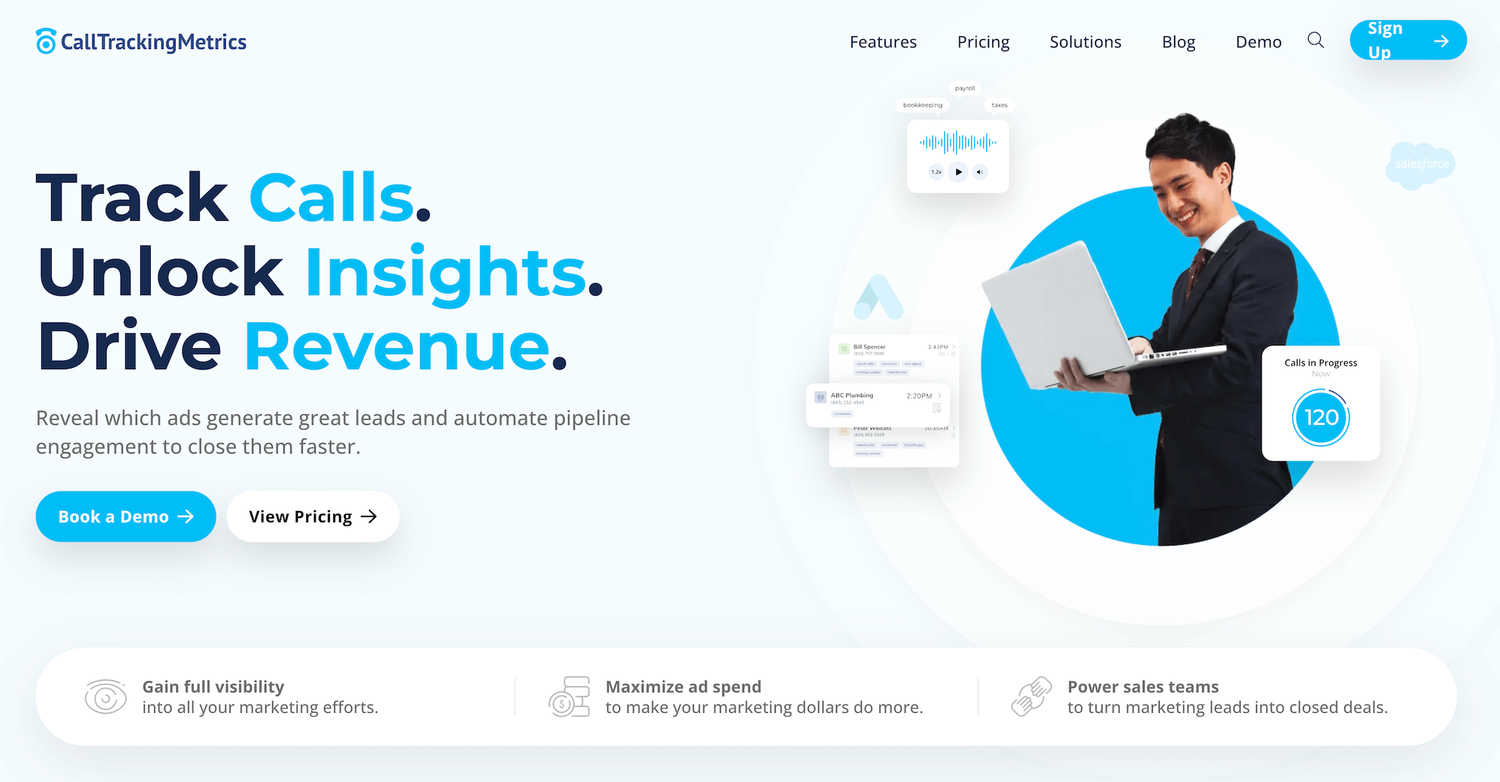
CallTrackingMetrics (CTM) can track inbound leads across texts, forms, calls, and chat conversations and can also be used by outbound sales teams. Its Keyword Spotting feature automatically flags keywords used by prospects in conversations as a part of conversational analysis.
CTM pricing starts at $65 per month per user when billed yearly and all plans support unlimited users. The Marketing Pro plan ($149 per user per month for annual billing) is a good fit for agencies that need to be able to set up sub-accounts. The company also provides professional services to help teams implement its solution faster.
4. WhatConverts: Campaign Performance Insights for Data-Driven Teams

WhatConverts supports ad and e-commerce agencies in tracking their marketing campaign performance. It’s used by healthcare companies, manufacturers, legal professionals, financial companies and real estate firms.
WhatConverts offers lead management tools and analytics features, for example:
- Lead qualification
- Lead export to CRM
- Real-time and custom reporting
- Marketing campaign tracking across channels
You can try out WhatConverts for free for 14 days. Pricing starts at $30 per month for single-account call and text tracking.
Turn Conversations Into Outcomes
Level AI helps QA teams and call center managers surface insights, follow call center quality assurance best practices, and improve customer satisfaction, without the manual overhead.
Book a personalized demo to see how Level AI can help your team drive efficiency and elevate performance.
Keep reading
View all





